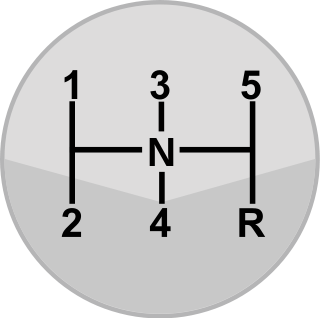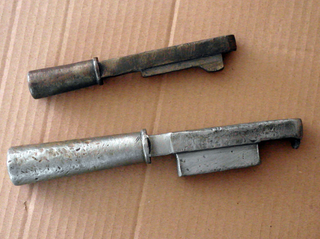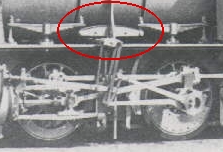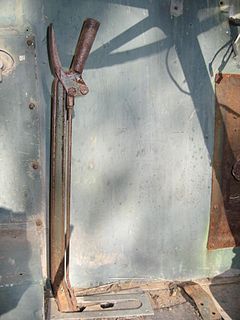This page is based on this
Wikipedia article Text is available under the
CC BY-SA 4.0 license; additional terms may apply.
Images, videos and audio are available under their respective licenses.

The Snowdon Mountain Railway is a narrow gauge rack and pinion mountain railway in Gwynedd, north-west Wales. It is a tourist railway that travels for 4.7 miles (7.6 km) from Llanberis to the summit of Snowdon, the highest peak in Wales.

A dead man's switch is a switch that is designed to be activated if the human operator becomes incapacitated, such as through death, loss of consciousness, or being bodily removed from control. Originally applied to switches on a vehicle or machine, it has since come to be used to describe other intangible uses like in computer software.

This is a glossary of the components found on typical steam locomotives.

The Walschaerts valve gear is a type of valve gear invented by Belgian railway mechanical engineer Egide Walschaerts in 1844 used to regulate the flow of steam to the pistons in steam engines. The gear is sometimes named without the final "s", since it was incorrectly patented under that name. It was extensively used in steam locomotives from the late 19th century until the end of the steam era.

An anti-roll bar is a part of many automobile suspensions that helps reduce the body roll of a vehicle during fast cornering or over road irregularities. It connects opposite (left/right) wheels together through short lever arms linked by a torsion spring. A sway bar increases the suspension's roll stiffness—its resistance to roll in turns, independent of its spring rate in the vertical direction. The first stabilizer bar patent was awarded to Canadian inventor Stephen Coleman of Fredericton, New Brunswick on April 22, 1919.

In road vehicles, the parking brake, also called hand brake, emergency brake, or e-brake, is used to keep the vehicle stationary and in many cases also perform an emergency stop. Parking brakes on older vehicles often consist of a cable connected to two wheel brakes at one end and the other end to a pulling mechanism which is operated with the driver's hand or foot. The mechanism may be a hand-operated lever, at floor level beside the driver, or a straight pull handle located near the steering column, or a (foot-operated) pedal located beside the drivers leg. In most automobiles the parking brake operates only on the rear wheels, which have reduced traction while braking. Some automobiles have the parking brake operate on the front wheels, for example most Citroens manufactured since the end of World War II, and the early models of the Saab 900.

The GWR Autocoach is a type of coach that was used by the Great Western Railway for push-pull trains powered by a steam locomotive. The distinguishing design feature of an autocoach is the driving cab at one end, allowing the driver to control the train without needing to be located in the cab of the steam locomotive. This eliminates the need to run the engine round to the other end of the coach at the end of each journey.

A gear stick, gear lever, gearshift or shifter is a metal lever attached to the shift assembly in a manual transmission-equipped automobile and is used to change gears. In an automatic transmission-equipped vehicle, a similar device is known as a gear selector. A gear stick will normally be used to change gear whilst depressing the clutch pedal with the left foot to disengage the engine from the drivetrain and wheels. Automatic transmission vehicles, semi-automatic transmissions, and those with continuously variable transmission gearboxes do not require a clutch pedal.

A bicycle handlebar or bicycle handlebars is the steering control for bicycles; it is the equivalent of a steering wheel for vehicles and vessels. Besides steering, handlebars also often support a portion of the rider's weight, depending on their riding position, and provide a convenient mounting place for brake levers, shift levers, cyclocomputers, bells, etc. Handlebars are attached to a bike's stem which in turn attaches to the fork.

A reverser handle is an operating control for a railroad locomotive that is used to determine the direction of travel. The reverser usually has three positions: forward, reverse, and neutral.

The 18 class was a class of 0-6-0T wheel arrangement steam locomotive built by Vulcan Foundry for the New South Wales Government Railways of Australia.
The Victorian Railways V Class is a steam locomotive, used on the Victorian Railways in the period 1900-1930.

The South African Railways Class 6L 4-6-0 of 1904 was a steam locomotive from the pre-Union era in the Cape of Good Hope.
On a steam locomotive, the reversing gear is used to control the direction of travel of the locomotive. It also adjusts the cutoff of the steam locomotive.

Gab valve gear was an early form of valve gear used on steam engines. Its simplest form allowed an engine to be stopped and started. A double form, mostly used on steam locomotives, allowed easy reversing.

An equalising beam, equalising lever or equalising bar links the suspension of two or more adjacent axles of a vehicle with more than two axles, especially railway locomotives. Its job is to provide 'compensated' springing, i.e. to ensure an even and statically determinate distribution of load to all the axles on uneven terrain or poorly laid track. The function of an equalising lever thus corresponds roughly to that of axle compensators or rockers (Achswippen).

The Lister Auto-Truck was a small monowheel tractor built for moving light loads around factories, railway yards and similar sites. They were built by R A Lister and Company of Dursley, Gloucestershire, well known for their range of small stationary engines.















